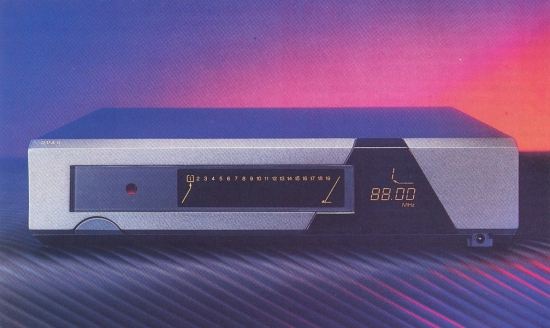Quad 66FM Tuner
The Quad 66FM tuner is a recent addition to the company's line of deluxe audio components, which includes the Model 66 preamplifier and the Model 66CD player. Each of the components is designed for complete compatibility with the others, and all are controlled from a single remote unit, which is supplied with the preamplifier.
Consistent with its place in an integrally designed and operated system, the Quad 66FM has no controls other than a barely visible power button. On the assumption that it will usually be used with the Quad 66 preamplifier, no remote control is supplied with the tuner, although it can be purchased separately. If you want to use the tuner without the preamp, you might also prevail upon your dealer to program a learning remote with the necessary commands from the big Quad integrated remote.
The tuner matches the preamplifier in size and external appearance. Its principal front-panel feature is a status display. At the right of the panel, the current preset channel number (nineteen are available) and its frequency appear in large amber numerals. To their left is a wider window with a row of numbers from 1 to 19 across its top. A long arrow points to the currently selected channel number, which is also enclosed in a small box, and there is a slanted row of illuminated squares whose length is proportional to the received signal strength. The word mono or stereo appears in the window as required.
On the tuner's rear apron are the AC power-cord socket, an unswitched AC convenience outlet, the audio output phono jacks, and a coaxial connector for a 75-ohm antenna feed.
The remote control is as unconventional as the components it was designed to operate. Several times as large as typical infrared remotes, it weighs about 2 pounds and matches the other Quad components in finish (a distinctive brownish-gray satin). Most of its controls, both buttons and knobs, are dedicated to operating the preamp and CD player, but among them is a button for selecting the tuner and pairs of search and track buttons that also control the CD player. Pressing the RADIO button turns on the tuner and switches the preamplifier input to it. The track and search buttons can then be used to select a desired preset number or to tune up or down the band. The STORE button is used to assign a tuned frequency to a selected preset. The track buttons step the tuning sequentially through the preset channels. The Quad 66FM, unlike most FM tuners, changes its tuning in 25-kHz increments, although'it normally displays only the usual 50-kHz intervals. The manual, which is quite complete, describes how to tune stations on intermediate channel frequencies (unlikely to be required in the United States, but possibly needed in other parts of the world).
In our lab tests, the tuner's frequency response was very flat, ±0.2 dB from 20 to 10,000 Hz and down only 0.7 dB at 15,000 Hz. Stereo channel separation was 40 to 45 dB in the midrange, narrowing to 25 dB at 30 and 15,000 Hz. Capture ratio, AM rejection, and image rejection were all well above average. Sensitivity and selectivity were adequate, though not outstanding, and the power-line hum in the tuner's output was absolutely undetectable. The Quad 66FM has no noise muting in the usual sense; its output is blanked out while tuning between stations, but not if the strength of a received signal drops to a very low level. The effective stereo threshold was 10 dBf, although the signal was too noisy to be useful at that level. The lowest signal-strength indicator segment came on about 20 dBf, and the next six segments illuminated at intervals of about 10 dB.
Once we had become familiar with the Quad 66FM's somewhat unconventional controls, using it became easy and natural. In general, it sounded better (under less than ideal conditions, with indoor dipole antennas) than most FM tuners we have used, by virtue of being essentially immune to extraneous noise radiated from nearby personal computers or compact disc players, which can inject considerable garbage into the spectrum at certain FM frequencies.
The remote control, despite its apparent clumsiness, weight, and size, proved to be one of the handiest we have used. It radiates a stronger infrared signal than most, enabling it to be placed on a table at a convenient location and pointed in any direction. It is not necessary, in most cases, to point it toward the controlled component, unlike most conventional remote controls. If all the major system components are Quad 66 series units, the Quad remote becomes a literal extension of the system controls.
The Quad 66 components, including the 66FM tuner, are not inexpensive, but I would judge that their value to a user easily justifies the investment. Considered either as a system or as individual components, their design is very user-friendly, and the audible results are thoroughly satisfying.




